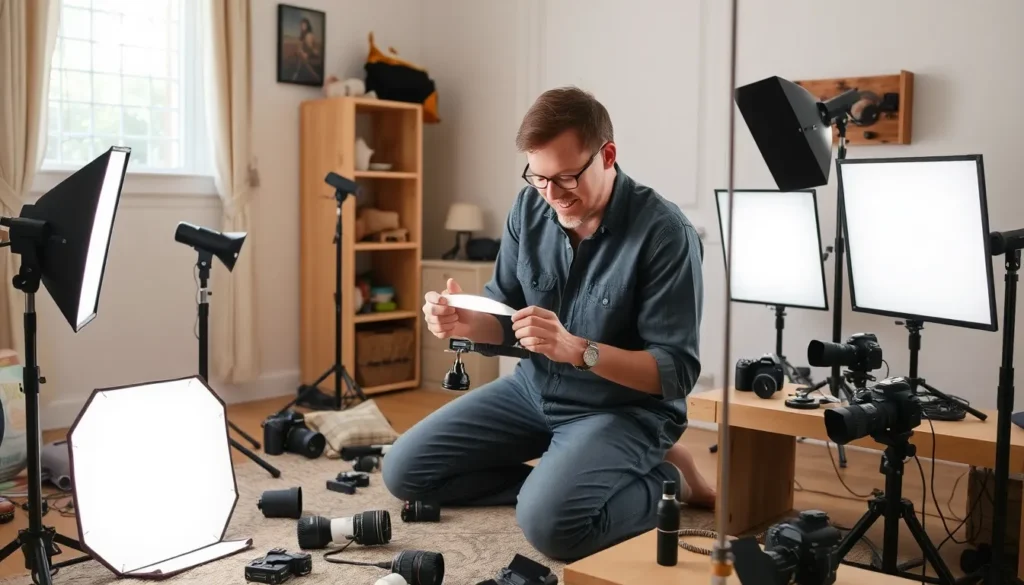In a world where selfies reign supreme, environmental portrait photography stands out like a unicorn at a dog park. It’s not just about snapping a picture; it’s about telling a story. This art form captures individuals in their natural habitats, revealing their personalities and passions while showcasing the world around them. Imagine a chef surrounded by fresh ingredients or an artist amid their vibrant creations—these portraits breathe life into a still image.
But wait, there’s more! Beyond the aesthetics, environmental portraits spark connections. They invite viewers into the subject’s world, creating an emotional bridge that a plain old headshot just can’t muster. So grab your camera and let’s dive into the fascinating realm of environmental portrait photography—where every click can turn an ordinary moment into an extraordinary tale.
Table of Contents
ToggleUnderstanding Environmental Portrait Photography
Environmental portrait photography captures people in their natural surroundings, emphasizing the relationship between the subject and the environment. This unique style conveys stories and emotions, allowing viewers to connect with the subjects on a deeper level.
Definition and Key Characteristics
Environmental portrait photography focuses on individuals within their context. It emphasizes the subject’s personality through their surroundings. Unlike standard portraits, it highlights elements like clothing and props that reveal interests or professions. This photography often incorporates natural light for authentic results. Composition plays a critical role, elevating the visual narrative through careful framing and angle selection. Additionally, colors, textures, and shapes enrich the portrait, making it more engaging.
Importance of Environment in Portraits
The environment significantly influences the storytelling aspect of portraits. A well-chosen setting complements the subject, enhancing their character traits. Contextual backgrounds provide insights into interests, professions, or lifestyles, adding depth to the image. In this type of photography, the environment becomes an active participant, shaping the overall narrative. Capturing dynamic interactions between the subject and their surroundings results in more engaging visuals. Effective environmental portraits foster emotional connections, inviting viewers to experience the subject’s world firsthand.
Techniques for Capturing Environmental Portraits

Effective environmental portrait photography requires thoughtful techniques. Key aspects include choosing the right location and utilizing natural light.
Choosing the Right Location
Selecting the right location greatly impacts the portrait’s story. A busy city street might convey energy, while a serene park can evoke tranquility. He or she should consider backgrounds that reflect the subject’s interests or profession. For instance, an artist fits well against a colorful mural or studio. Contextual relevance enhances viewer engagement, providing a deeper understanding of the subject. Exploring various locations ensures diverse storytelling possibilities. Walk around potential sites to find unexpected backdrops, allowing for creative compositions. Combining local culture and environment adds authenticity to the portrait too.
Utilizing Natural Light
Natural light plays a vital role in environmental portrait photography. It creates a soft, flattering effect that enhances the subject’s features without harsh shadows. He or she should pay attention to time of day, as golden hour often produces the most appealing lighting. Observing how sunlight interacts with the environment yields unique results. Use diffused light on overcast days for a gentle glow, or seek out intriguing shadows for added depth. Positioning the subject to optimize light direction can amplify mood and emotion. Natural light not only illuminates the subject but also integrates the surrounding environment into the portrait seamlessly.
Equipment for Environmental Portrait Photography
Choosing the right equipment significantly impacts the quality of environmental portraits. Proper tools enhance storytelling, ensuring the subject shines within their context.
Recommended Cameras and Lenses
Full-frame DSLRs or mirrorless cameras deliver superior results for environmental portraits. Popular options include the Canon EOS R5, Nikon Z7 II, and Sony A7 III, each boasting excellent image quality. A versatile zoom lens, like a 24-70mm f/2.8, supports various compositions. Prime lenses, such as 50mm f/1.8 or 85mm f/1.4, provide incredible sharpness and beautiful bokeh. Each lens choice allows photographers to emphasize subjects while maintaining environmental context.
Accessories That Enhance Quality
Filters, tripods, and reflectors elevate environmental portrait photography. Polarizing filters reduce glare and enhance colors. A sturdy tripod stabilizes the camera, crucial for low-light settings or long exposures. Using reflectors softens light on the subject, creating balanced illumination. Additional accessories, like external flashes or softboxes, improve lighting in challenging situations. Investing in quality gear ensures photographers capture compelling images that resonate with viewers.
Creative Approaches to Environmental Portraits
Environmental portrait photography thrives on creative approaches that enhance storytelling and connect viewers to the subject. Techniques such as composition and personal elements play pivotal roles in this art form.
Storytelling Through Composition
Composition shapes the narrative within environmental portraits. Strategic framing draws attention to the subject while incorporating contextual elements. Perspective creates depth, blending foreground, mid-ground, and background effectively. Utilize leading lines to guide viewers’ eyes toward the subject, emphasizing their importance. Balance within the frame fosters harmony, ensuring that neither the subject nor the environment overshadows the other. Capturing moments that reveal interaction with surroundings provides dynamic storytelling. Consider angles that evoke emotion, transforming simple photographs into compelling visual narratives.
Incorporating Personal Elements
Personal elements infuse environmental portraits with individuality and authenticity. Meaningful objects can enhance the story told through an image. Props related to the subject’s profession or hobbies add depth and context to their personality. Consider items like musical instruments, tools, or books that resonate with the subject’s life. Integrating clothing that reflects personal style or cultural background strengthens the connection with viewers. Focusing on specific details, such as tattoos or cherished items, further personalizes the portrait. This approach invites viewers to engage with the subject’s unique story, creating a more intimate experience.
Environmental portrait photography offers a powerful way to capture the essence of individuals within their surroundings. By emphasizing the relationship between the subject and their environment, this art form invites viewers to connect on a deeper level. Each portrait tells a unique story that goes beyond mere visuals, showcasing personality and context in a compelling manner.
As photographers embrace the techniques and tools discussed, they can elevate their work to new heights. Whether through careful composition or the strategic use of natural light, the potential for creativity is limitless. Ultimately, environmental portraits not only document moments but also celebrate the rich narratives behind each subject, making them an indispensable part of the photography landscape.



